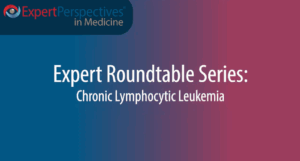Oncology
Chronic Lymphocytic Leukemia
Frontline Therapy in Chronic Lymphocytic Leukemia
Determining when to begin frontline therapy for CLL is challenging. Not all patients need to be treated. I am staunchly in the camp of “do not start therapy until it is clear that you need to.” I also follow the International Workshop on Chronic Lymphocytic Leukemia (iwCLL) guidelines. Generally, patients with CLL should be experiencing either symptoms or fairly rapid progression to consider starting treatment. It is also important to remember that most of our patients are older; their median age is around 70 years, and some may never require therapy.
<br>
The question of what to treat patients with CLL with is also a challenge. We have 2 approaches: BTK inhibitors and BCL-2 inhibitors, with or without an anti-CD20 antibody. Both approaches are very effective. It comes down to what the patient wants and the potential impact of treatment on their life. Will they need to travel to a center for infusions? Can they just take a pill? What are the potential adverse effects?
<br>
This is where I individualize treatment. For a younger patient with CLL, I might be more aggressive and choose a BCL-2 inhibitor plus an antibody. For an older patient, I might use a second-generation BTK inhibitor with sequential therapy instead of combination therapy. Again, the treatment of each case needs to be individualized and include a discussion of treatment goals with the patient.
<br>
We have witnessed tremendous progress in CLL; newer targeted approaches unequivocally show better outcomes compared with chemoimmunotherapy in almost all settings. The emergence of resistance to BTK inhibitors is still an issue, but we have an exciting option available in the noncovalent BTK inhibitor pirtobrutinib, which has been approved by the US Food and Drug Administration (FDA), and newer BTK inhibitors and degraders are under investigation for CLL.
I agree with Dr Maloney that many patients have smoldering CLL that may never require intervention. There are no data indicating that early intervention is superior to active observation. The recently reported CLL12 study from the German CLL Study Group showed that this is still true for targeted therapy. In the study, having patients on “active observation”—a term that I like better than “watch and wait”—was the right thing to do.
<br>
When patients with CLL do require intervention, we are in a golden era with plenty of options, all of which can be discussed with the patient. Topics that should be included in the discussion are duration of treatment, number of agents used, treatment goals, and type of follow-up. And do not forget to also ask the patient, “What is going on in your life? What is the best fit for you right now?”
<br>
There may be concerns about the availability of agents at a reasonable cost to the patient, which can be a factor when choosing treatment. Similarly, practicing in an urban or a rural area may require decisions based on practicality, such as a patient’s distance from a center. I also try to encourage participation in clinical trials whenever that is feasible. At our center, we have several options for frontline therapy that are accessed through enrollment in a clinical trial. That is how we advance the field.
<br>
Other important considerations are comorbidities and concomitant medications because there can be class-related toxicities. We want to match the best treatment with the patient. For example, if the patient has a significant history of cardiac arrhythmias, BTK inhibitors may not be the best choice. In addition, if there is a past or present concern about renal function, we need to be very careful with BCL-2 inhibitors because of the risk of tumor lysis syndrome.
This area is continuing to evolve, and we have completely moved away from chemoimmunotherapy toward targeted therapies. In the field of CLL, we now have the option of continuous or time-limited therapy, and there are several choices within those subsets.
<br>
For example, BTK inhibitors that are FDA approved for continuous therapy include ibrutinib, acalabrutinib, and zanubrutinib. The time-limited approach of venetoclax plus obinutuzumab for 1 year is FDA approved, but we are also expecting approvals for acalabrutinib plus venetoclax and for the triplet combination of acalabrutinib, venetoclax, and obinutuzumab hopefully soon.
<br>
Choosing frontline treatment is a nuanced decision, with pros and cons for the 2 approaches. The time-limited approach can appear easier than continuous therapy because it is just for 1 year, as opposed to taking a pill every day for a very long time. However, the time-limited approach generally requires 2 or 3 drugs, which can mean more toxicities and monitoring requirements with the risk of infusion reactions and, possibly, the need for hospitalization.
<br>
In my practice, I discuss both continuous and time-limited options with patients. Most of my younger patients with CLL, especially those aged 60 to 65 years, tend to favor time-limited approaches. Conversely, I have patients in their 80s who do not want to go to the hospital for repeated infusions, are worried about infusion reactions, and do not mind taking an extra pill each day. So, treatment selection becomes a shared decision with the patient.
<br>
I am finding that more patients with CLL overall are opting for time-limited approaches because they can achieve a deep remission, complete treatment in 1 year, and then enter a prolonged observation period without the need for treatment. If the disease returns further down the line, they can either be re-treated with the same regimen or potentially choose a new therapy at that time.
Al-Sawaf O, Robrecht S, Zhang C, et al. Venetoclax-obinutuzumab for previously untreated chronic lymphocytic leukemia: 6-year results of the randomized phase 3 CLL14 study. Blood. 2024;144(18):1924-1935. doi:10.1182/blood.2024024631
<br>
Arguello-Tomas M, Albiol N, Moreno C. Frontline therapy in chronic lymphocytic leukemia. Acta Haematol. 2024;147(1):47-59. doi:10.1159/000534730
<br>
Brown JR, Seymour JF, Jurczak W, et al; AMPLIFY Investigators. Fixed-duration acalabrutinib combinations in untreated chronic lymphocytic leukemia. N Engl J Med. 2025;392(8):748-762. doi:10.1056/NEJMoa2409804
<br>
Guru Murthy GS, Atallah E. Venetoclax-based treatment as frontline therapy for chronic lymphocytic leukemia. Hematol Oncol Stem Cell Ther. 2023;16(4):346-350. doi:10.56875/2589-0646.1039
<br>
Hallek M, Cheson BD, Catovsky D, et al. iwCLL guidelines for diagnosis, indications for treatment, response assessment, and supportive management of CLL. Blood. 2018;131(25):2745-2760. doi:10.1182/blood-2017-09-806398
<br>
Langerbeins P, Robrecht S, Nieper P, et al. Ibrutinib in early-stage chronic lymphocytic leukemia: the randomized, placebo-controlled, double-blind, phase III CLL12 trial. J Clin Oncol. 2025;43(4):392-402. doi:10.1200/JCO.24.00975
<br>
Tausch E, Schneider C, Stilgenbauer S. Risk-stratification in frontline CLL therapy: standard of care. Hematology Am Soc Hematol Educ Program. 2024;2024(1):457-466. doi:10.1182/hematology.2024000656
<br>
Woyach JA, Stephens DM, Flinn IW, et al. First-in-human study of the reversible BTK inhibitor nemtabrutinib in patients with relapsed/refractory chronic lymphocytic leukemia and B-cell non-Hodgkin lymphoma. Cancer Discov. 2024;14(1):66-75. doi:10.1158/2159-8290.CD-23-0670













